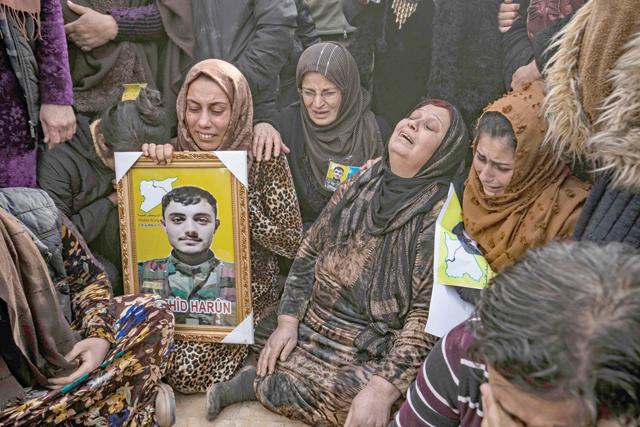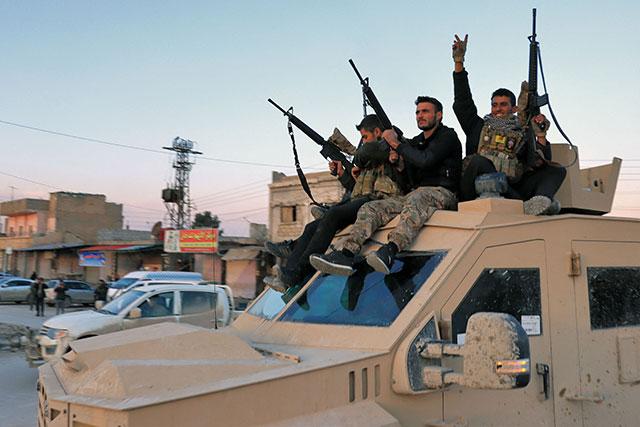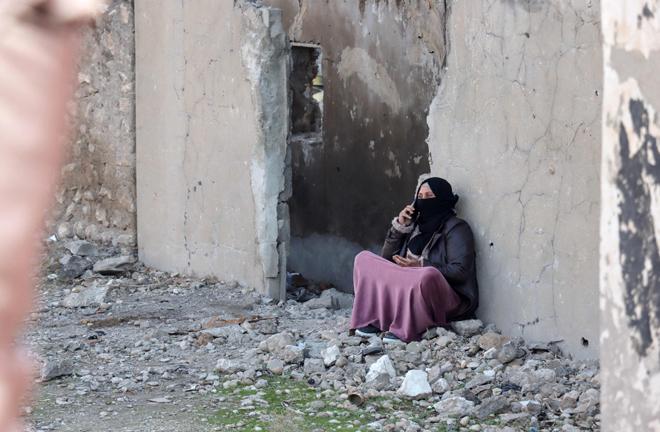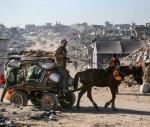You are here
Extremist fighters holed up with minors in Syria prison
By AFP - Jan 24,2022 - Last updated at Jan 24,2022

Syrian Democratic Forces patrol a street in the northern Syrian city of Hasakeh on Sunday (AFP photo)
HASAKEH, Syria — Kurdish forces geared up on Monday for an assault on a prison in northeast Syria that the Daesh terror group fighters stormed last week, sparking fears over the fate of hundreds of under-age detainees.
Daesh fighters on Thursday rammed two explosives-packed vehicles into the Kurdish-run Ghwayran Prison to launch a brazen jailbreak operation that has plunged the city of Hasakeh into chaos.
The attack, the group’s biggest since their once sprawling proto-state was defeated in 2019, has already killed more than 150 people, including more than 100 among extremist ranks.
Fighting drove hundreds of residents of Syria’s largest Kurdish city to flee, but the violence receded on Monday, with the presence of hundreds of children inside the prison complicating an assault.
The Britain-based group Syrian Observatory for Human Rights said elite Kurdish forces had moved armoured vehicles inside the main prison yard, ahead of a possible attempt to storm the facility.
Daesh fighters were holed up in one building on the northern side of the prison after “dozens of jihadists surrendered to Kurdish forces” in recent hours, according to the war monitoring group.
Farhad Shami, a spokesman for the Kurdish-led Syrian Democratic Forces (SDF), said several Daesh members had handed themselves over following an SDF raid inside the jail.
An AFP correspondent in the area saw buses and military vehicles transferring what appeared to be Daesh fighters out of the prison.
The autonomous Kurdish authorities running the region imposed a state of emergency across Hasakeh, after at least seven civilians were caught in the crossfire and killed.
According to rights groups and the United Nations, more than 700 minors are thought be held in Ghwayran, a former school converted into a detention facility that is badly overcrowded, housing at least 3,500 suspected Daesh members.
“These children are effectively trapped in Ghwayran prison,” said Sara Kayyali, Syria researcher at the group Human Rights Watch (HRW).
HRW heard voice messages from an injured minor at Ghwayran who reported “there are dead bodies everywhere”, Kayyali said.
“It’s not clear if they have any kind of medical assistance,” Kayyali added, explaining that most of the minors were aged between 12 and 18.
Another group, Save the Children, said it had also received audio testimony indicating that “there have already been multiple child deaths and casualties”.
It said the minors in Ghwayran are from dozens of foreign countries, as well as Syria and Iraq.
The SDF, the autonomous Kurdish authorities’ de facto army, charged IS attackers were using children as human shields to prevent an assault.
The extremist group “continues to hold children hostage and is using them as human shields to protect themselves”, the SDF said in statement.
Eva Hinds, spokeswoman for UN childrens’ agency UNICEF, said the plight of the trapped minors, around 10 per cent of whom are believed to be 15 or younger, was a source of “grave concern”.
“The SDF initially allocated a special section for children,” Hinds said. “Many of them have adult relatives inside and have since joined them in other sections.”
The US forces based in the region, who were the main support in the Kurdish offensives that put thousands of extremists into custody three years ago, were heavily deployed in Hasakeh.
US-led coalition helicopters were flying overhead as a full curfew was enforced across the city, an AFP correspondent reported.
“If Daesh is using these children as human shields, and the SDF and the US-led coalition are trying to retake the prison, then the children are at incredible risk from both sides,” Kayyali said.
According to the observatory war monitor, at least 154 people were killed since the attack was launched late on January 20.
Among them were 102 extremists, 45 members of the Kurdish security forces and seven civilians, Observatory head Rami Abdel Rahman said.
The attack on one of the biggest prisons in the region was seen by analysts as a sign that Daesh needs manpower to continue rebuilding following the demise of its “caliphate”.
While it is unclear how successful Daesh will have been at springing fighters from Ghwayran, the operation marks a new step in the extremist organisation’s resurgence.
But observers also argued that while Daesh has trumpeted the attack on its propaganda channels and that it might provide a morale boost for Daesh sympathisers, it would do little to change the military balance on the ground.
Related Articles
BEIRUT — The United Nations said on Sunday that minors were still being detained in a northeast Syria prison attacked last month by the Daes
HASAKEH, Syria — Kurdish-led forces on Thursday found dozens of terrorists holed up in a Syrian prison as they carried out mop-up operation
HASAKEH, Syria — Fighting raged for a third day Saturday between the Daesh terror group and Kurdish forces in Syria after Daesh attacked a p


















